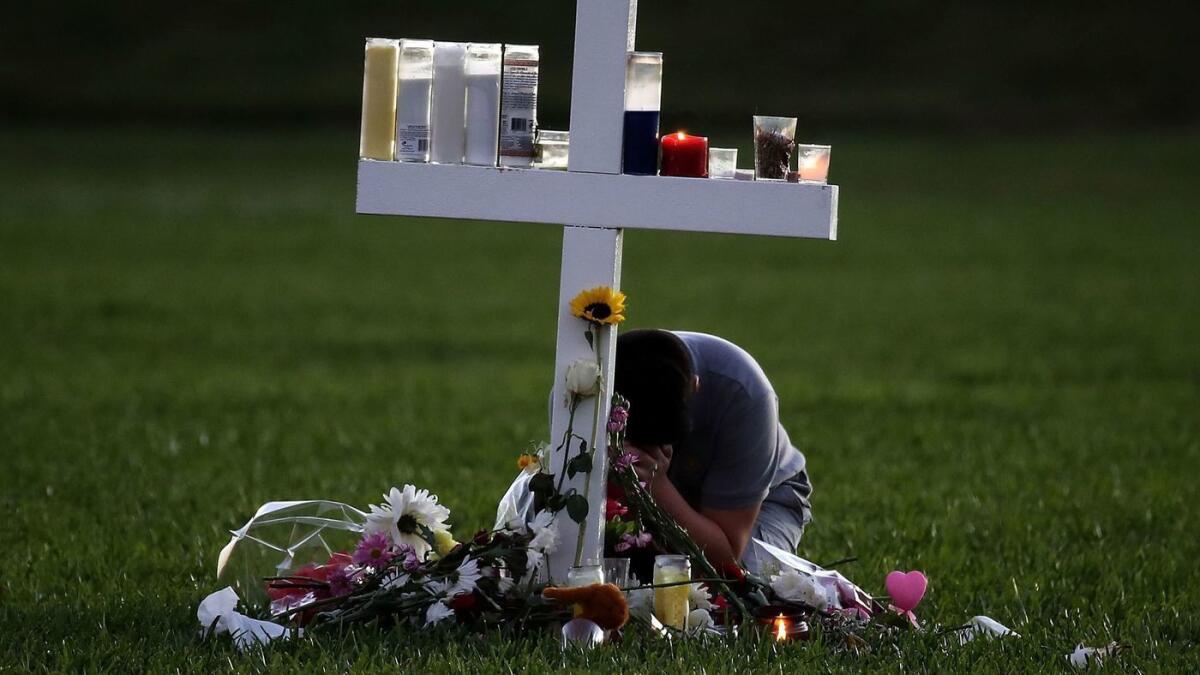Op-Ed: There is something states can do to prevent school shootings: Pass a ‘red flag’ law

- Share via
I have one question for lawmakers in Washington and in statehouses across the nation: How many people must die before you do something?
It was not enough when 26 people, kids and educators, were gunned down at Sandy Hook Elementary School. Or when 49 people died at the Pulse nightclub in Orlando, Fla. Or when 58 concertgoers were shot and killed, and hundreds more were injured, in Las Vegas. Or when 26 worshippers were killed in church in Sutherland Springs, Texas.
For too many of our elected officials it is simply inevitable that more than 90 Americans will be shot and killed every single day in our neighborhoods, while hundreds of others are wounded. It is simply inevitable that 17 students and teachers would die at Marjory Stoneman Douglas High School in Parkland, Fla.
Very quickly this week we discovered that the Parkland gunman had a history of threatening behavior coupled with easy access to firearms. People who knew the shooter recognized he was troubled. He enjoyed showing off his firearms and students and teachers considered him to be dangerous. In fact according to reports, the gunman’s mother had called the police more than once about her son’s behavior.
These were portents of violence, and they might have prevented the Parkland massacre if lawmakers had followed the lead of California, Washington, Oregon, Indiana and Connecticut, and put into effect “red flag” laws.
Although we will never be able to prevent every gunman and every shooting tragedy, red flag laws can help. They enable family members or law enforcement to petition the courts to temporarily prohibit a person from having guns if he poses a danger to himself or others. The process creates an opportunity to intervene before warning signs escalate into murder.
My son Christopher was shot and killed in Isla Vista, Calif., on May 14, 2014. The gunman displayed numerous warning signs in the days and weeks leading up to his rampage. He made homicidal and suicidal threats. His parents alerted law enforcement, but police decided he did not meet the criteria for emergency commitment. He was able to keep his guns and use them in the killing spree that ended Christopher’s life. The red flag mechanism wasn’t in place to allow law enforcement to step in.
I turned my grief into action and fought in the California Legislature to pass the state’s red flag law in Christopher’s name. I was gratified when it was signed that September.
Red flag laws empower families and local law enforcement officials — who are in a position to assess threatening behavior that might tip toward lethality — to defuse potentially tragic situations. Even the temporary removal of guns in such circumstances can be the difference between life and death.
We’ll undoubtedly hear from the gun lobby that the solution to the Parkland violence is more guns, in more places. It’s absurd on its face, and it’s wrong.
The students who survived at Marjory Stoneman Douglas High School are speaking out clearly in the media and at vigils: They don’t want more guns in their classrooms or in their communities. They want safety, for themselves, their friends and their loved ones.
The burden of unrelenting violence is too much for our children.
They sound a lot like 7-year-old Ava Olsen, who sent a letter to President Trump after her classmate, Jacob, was gunned down during recess in Townville, S.C., in 2016. Ava told the president that a gun had ruined her life and taken her best friend. “Are you going to keep kids safe?” she asked Trump. “How can you keep us safe?”
Let’s add Ava’s questions to the one I posed at the beginning of this essay. Lawmakers: Are you going to keep kids safe? How can you keep us safe? And: How many people must die?
The burden of unrelenting violence is too much for our children. It’s too much for parents like me. There is no such thing as “too soon” to talk about passing laws to prevent gun violence — there is only “too late.”
Richard Martinez is a member of the Everytown Survivor Network and senior associate for Everytown for Gun Safety.
Follow the Opinion section on Twitter @latimesopinion and Facebook
More to Read
A cure for the common opinion
Get thought-provoking perspectives with our weekly newsletter.
You may occasionally receive promotional content from the Los Angeles Times.









